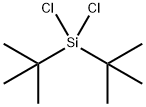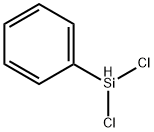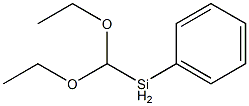Dichlorodiethylsilane
- CAS NO.:1719-53-5
- Empirical Formula: C4H10Cl2Si
- Molecular Weight: 157.11
- MDL number: MFCD00000493
- EINECS: 217-005-0
- SAFETY DATA SHEET (SDS)
- Update Date: 2025-01-27 09:38:02

What is Dichlorodiethylsilane?
Chemical properties
colourless liquid
The Uses of Dichlorodiethylsilane
Dichlorodiethylsilane is used in ethchlorvynol assay. It is used in Organic Synthesis, Pharmaceuticals, Agrochemicals and Dyestuffs.
The Uses of Dichlorodiethylsilane
Used primarily as an intermediate for silicones.
Production Methods
Produced by reaction of powdered silicon and ethyl chloride at 300℃, in the presence of copper powder.
General Description
A colorless liquid with a pungent odor. Flash point 77°F. Corrosive to metals and tissue. Vapors are heavier than air.
Reactivity Profile
Chlorosilanes, such as Dichlorodiethylsilane, are compounds in which silicon is bonded to from one to four chlorine atoms with other bonds to hydrogen and/or alkyl groups. Chlorosilanes react with water, moist air, or steam to produce heat and toxic, corrosive fumes of hydrogen chloride. They may also produce flammable gaseous H2. They can serve as chlorination agents. Chlorosilanes react vigorously with both organic and inorganic acids and with bases to generate toxic or flammable gases.
Health Hazard
TOXIC; inhalation, ingestion or contact (skin, eyes) with vapors, dusts or substance may cause severe injury, burns or death. Bromoacetates and chloroacetates are extremely irritating/lachrymators. Reaction with water or moist air will release toxic, corrosive or flammable gases. Reaction with water may generate much heat that will increase the concentration of fumes in the air. Fire will produce irritating, corrosive and/or toxic gases. Runoff from fire control or dilution water may be corrosive and/or toxic and cause pollution.
Fire Hazard
HIGHLY FLAMMABLE: Will be easily ignited by heat, sparks or flames. Vapors form explosive mixtures with air: indoors, outdoors and sewers explosion hazards. Most vapors are heavier than air. They will spread along ground and collect in low or confined areas (sewers, basements, tanks). Vapors may travel to source of ignition and flash back. Substance will react with water (some violently) releasing flammable, toxic or corrosive gases and runoff. Contact with metals may evolve flammable hydrogen gas. Containers may explode when heated or if contaminated with water.
Safety Profile
Poison by intraperitoneal route. Moderately toxic by ingestion. Corrosive to tissue. Dangerous fire hazard when exposed to heat, flame, or oxidzers. Can react vigorously with oxidizing materials. To fight fire, use foam, Con, dry chemical. When heated to decomposition or in reaction with water or steam it emits toxic and corrosive fumes of Cl-. See also CHLOROSILANES.
Properties of Dichlorodiethylsilane
| Melting point: | -96 °C |
| Boiling point: | 125-131 °C(lit.) |
| Density | 1.05 g/mL at 25 °C(lit.) |
| refractive index | n |
| Flash point: | 83 °F |
| storage temp. | Flammables area |
| form | liquid |
| color | Colorless to Almost colorless |
| Specific Gravity | 1.05 |
| Water Solubility | insoluble |
| Sensitive | Moisture Sensitive |
| Hydrolytic Sensitivity | 8: reacts rapidly with moisture, water, protic solvents |
| BRN | 605313 |
| Stability: | Stable. Incompatible with strong oxidizing agents. May decompose upon exposure to water or moisture. |
| CAS DataBase Reference | 1719-53-5(CAS DataBase Reference) |
| NIST Chemistry Reference | Dichlorodiethylsilane(1719-53-5) |
| EPA Substance Registry System | Diethyldichlorosilane (1719-53-5) |
Safety information for Dichlorodiethylsilane
| Signal word | Danger |
| Pictogram(s) |
 Flame Flammables GHS02  Corrosion Corrosives GHS05  Exclamation Mark Irritant GHS07 |
| GHS Hazard Statements |
H226:Flammable liquids H302:Acute toxicity,oral H314:Skin corrosion/irritation H335:Specific target organ toxicity, single exposure;Respiratory tract irritation |
| Precautionary Statement Codes |
P210:Keep away from heat/sparks/open flames/hot surfaces. — No smoking. P280:Wear protective gloves/protective clothing/eye protection/face protection. P303+P361+P353:IF ON SKIN (or hair): Remove/Take off Immediately all contaminated clothing. Rinse SKIN with water/shower. |
Computed Descriptors for Dichlorodiethylsilane
New Products
Indole Methyl Resin tert-butyl 9-methoxy-3-azaspiro[5.5]undecane-3-carboxylate Boc-His(Boc)-OH 2-CTC Resin 4-Chloro-7-tosy1-7Hpyrrolo[2,3-d]pyrimidine 5,7-Dibromo-1H-indole 2,5-dichloro-N-hydroxy-4,6-dimethylpyridine-3-carboximidamide 2,2-Dimethoxy-7-azaspiro[3.5]nonane hydrochloride 4-chloromethyl-5-methyl-1,3-dioxol-2-one (DMDO-Cl) R-2-BENZYLOXY PROPIONIC ACID 1,1’-CARBONYLDIIMIDAZOLE 1,1’-CARBONYLDI (1,2-4 TRIAZOLE) N-METHYL INDAZOLE-3-CARBOXYLIC ACID 4-((2-hydroxyethyl)thio)benzoic acid 1-(TERT-BUTOXYCARBONYL)-2-PYRROLIDINONE Methyl 6-methylnicotinate 3-Pyridineacrylic acid tert-Butyl carbazate TETRAHYDRO-2H-PYRAN-3-OL 2-((4-morpholinophenylamino) (methylthio) methylene) malononitrile 3-(4-morpholinophenylamino)-5-amino-1H-pyrazole-4-carbonitrile 2,4-dihydroxybenzaldehyde 1,3-Diethyl-1,3-Diphenylurea Methyl 2-methylquinoline-6-carboxylateRelated products of tetrahydrofuran








You may like
-
 Dichlorodiethylsilane CAS 1719-53-5View Details
Dichlorodiethylsilane CAS 1719-53-5View Details
1719-53-5 -
 Dichlorodiethylsilane CAS 1719-53-5View Details
Dichlorodiethylsilane CAS 1719-53-5View Details
1719-53-5 -
 Dichlorodiethylsilane CAS 1719-53-5View Details
Dichlorodiethylsilane CAS 1719-53-5View Details
1719-53-5 -
 Pyridine 99.5% HPLC /UV SpectroscopyView Details
Pyridine 99.5% HPLC /UV SpectroscopyView Details
110-86-1 -
 Piperazine Spot supply, best priceView Details
Piperazine Spot supply, best priceView Details
110-85-0 -
 Dibutyl PhthalateView Details
Dibutyl PhthalateView Details
84-74-2 -
 Imidazole Spot supply, competitive priceView Details
Imidazole Spot supply, competitive priceView Details
288-32-4 -
 Thiourea 99% ARView Details
Thiourea 99% ARView Details
62-56-6
